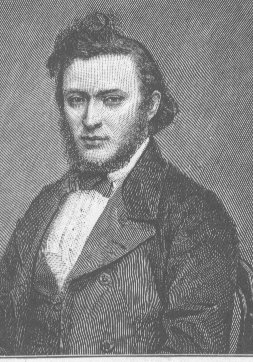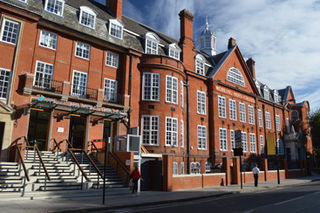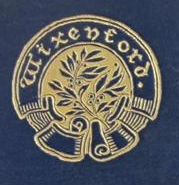
The Royal Dramatic College was a home for retired actors in Woking, England; it was opened by the Prince of Wales (later Edward VII) in 1865, and closed because of financial difficulty in 1877.

The Royal Dramatic College was a home for retired actors in Woking, England; it was opened by the Prince of Wales (later Edward VII) in 1865, and closed because of financial difficulty in 1877.
On 21 July 1858, at the Princess's Theatre, London, there was a well-attended meeting, chaired by the actor Charles Kean, to discuss the feasibility of providing almshouses for retired actors. Charles Dickens and William Makepeace Thackeray were among those present. As a result of the meeting a trust was formed, and a suitable site for the proposed building was found, in Woking where a ten-acre site in Maybury Common was purchased from the London Necropolis Company for £750. [1] [2] [3]

This followed the inauguration, in June 1858, of a burial ground for actors, in an acre purchased from the London Necropolis Company in Woking. This site was selected by John W. Anson, Secretary of the Dramatic, Equestrian and Musical Sick Fund, which provided members with financial help when ill and a decent burial. Actors could not otherwise rely on such things: a report of the inauguration of the burial ground commented "Before this was obtained, a parish funeral, or cast among strangers, too frequently in from 6-16 inches of water, was the fate of many." Anson later became Secretary of the college. [2] [4] [5]
In the autumn of 1858, Prince Albert became patron. On 9 June 1860 he travelled to Woking on a special train and laid the foundation stone of the building. [1] [2]
After the death of Prince Albert, his son the Prince of Wales, later Edward VII, became patron. On 5 June 1865 he officially opened the College. The building, designed by T. R. Smith, had a central hall and two wings, each containing several self-contained "houses". [1] [2]

The actor Thomas Cooke gave much financial support. One of his last appearances, at Covent Garden in 1860, was for the benefit of the College. He died in 1864, and left £2000 to the College to be invested to provide a prize for "the best Drama on a Nautical or National subject", and £1000 to fund an annual dinner for the College. A. R. Slous's True to the Core: a Story of the Armada won the first drama prize and was performed on 8 Sept 1866 at the Surrey Theatre. J. S. Dilley and James Albery's The Mate of the Mountjoy, which was unperformed, won in 1868. [6]
From 1870 the College was in financial difficulties; the building costs had been higher than expected and the running costs were high. Thomas Cooke's benefaction was insufficient and there was little public interest. In November 1877 the trustees decided to close the college. [1] [7]
The building was sold in 1884 to G. W. Leitner for a proposed Oriental Institute. The Institute closed after Leitner's death in 1899, and the building became a factory for aircraft and motorcycle manufacturer Martinsyde and later for James Walker Ltd. The building was demolished in the 1990s, and the Lion Retail Park now stands on the site (coordinates 51°19′24″N0°32′35″W / 51.32333°N 0.54306°W ). [1] [7] [8]

Golders Green Crematorium and Mausoleum was the first crematorium to be opened in London, and one of the oldest crematoria in Britain. The land for the crematorium was purchased in 1900, costing £6,000, and the crematorium was opened in 1902 by Sir Henry Thompson.

Kensal Green Cemetery is a cemetery in the Kensal Green area of North Kensington in the Royal Borough of Kensington and Chelsea and the London Borough of Hammersmith and Fulham in London, England. Inspired by Père Lachaise Cemetery in Paris, it was founded by the barrister George Frederick Carden. The cemetery opened in 1833 and comprises 72 acres (29 ha) of grounds, including two conservation areas, adjoining a canal. The cemetery is home to at least 33 species of bird and other wildlife. This distinctive cemetery has memorials ranging from large mausoleums housing the rich and famous to many distinctive smaller graves and includes special areas dedicated to the very young. It has three chapels and serves all faiths. It is one of the Magnificent Seven cemeteries in London.

The London Necropolis Company (LNC), formally the London Necropolis & National Mausoleum Company until 1927, was a cemetery operator established by Act of Parliament in 1852 in reaction to the crisis caused by the closure of London's graveyards in 1851. The LNC intended to establish a single cemetery large enough to accommodate all of London's future burials in perpetuity. The company's founders recognised that the recently invented technology of the railway provided the ability to conduct burials far from populated areas, mitigating concerns over public health risks from living near burial sites. Accordingly, the company bought a large tract of land in Brookwood, Surrey, around 25 miles (40 km) from London, and converted a portion of it into Brookwood Cemetery. A dedicated railway line, the London Necropolis Railway, linked the new cemetery to the city.

Brookwood Cemetery, also known as the London Necropolis, is a burial ground in Brookwood, Surrey, England. It is the largest cemetery in the United Kingdom and one of the largest in Europe. The cemetery is listed a Grade I site in the Register of Historic Parks and Gardens.

London Necropolis railway station was the terminus at Waterloo, London, of the London Necropolis Railway. The London Necropolis was opened in 1854 in response to severe overcrowding in London's existing graveyards and cemeteries. It aimed to use the recently developed technology of the railway to move as many burials as possible to the newly built Brookwood Cemetery in Brookwood, Surrey. This location was within easy travelling distance of London, but distant enough for the dead not to pose any risk to public hygiene. There were two locations for the station; the first was in operation from 1854 to 1902, the second from 1902 to 1941.

Gottlieb Wilhelm Leitner, also known as Gottlieb William Leitner, was a British orientalist.

Woking means"(settlement belonging to the) followers of Wocc ". Over time, the name has been written variously as, for example, Wochingas, and Wokynge.
Events from the year 1807 in Ireland.

The Working Men's College, is among the earliest adult education institutions established in the United Kingdom, and Europe's oldest extant centre for adult education. Founded by Christian socialists, at its inception it was at the forefront of liberal education philosophy. Today the college has two centres in the London Borough of Camden.

The Shah Jahan Mosque on Oriental Road, Woking, England, is the first purpose-built mosque in the United Kingdom. Built in 1889, it is located 30 miles (50 km) southwest of London. It is a Grade I listed building.

Woking is a town and borough in northwest Surrey, England, around 23 mi (36 km) from central London. It appears in Domesday Book as Wochinges, and its name probably derives from that of a Saxon landowner. The earliest evidence of human activity is from the Paleolithic, but the low fertility of the sandy local soils meant that the area was the least populated part of the county in 1086. Between the mid-17th and mid-19th centuries, new transport links were constructed, including the Wey Navigation, Basingstoke Canal and London to Southampton railway line. The modern town was established in the mid-1860s, as the London Necropolis Company began to sell surplus land surrounding the railway station for development.

The London Necropolis Railway was a railway line opened in November 1854 by the London Necropolis Company (LNC), to carry corpses and mourners between London and the LNC's newly opened Brookwood Cemetery, 23 miles (37 km) southwest of London in Brookwood, Surrey. At the time the largest cemetery in the world, Brookwood Cemetery was designed to be large enough to accommodate all the deaths in London for centuries to come, and the LNC hoped to gain a monopoly on London's burial industry. The cemetery had intentionally been built far enough from London so as never to be affected by urban growth and was dependent on the recently invented railway to connect it to the city.

Woking Crematorium is a crematorium in Woking, a large town in the west of Surrey, England. Established in 1878, it was the first custom-built crematorium in the United Kingdom and is closely linked to the history of cremation in the UK.

David Nunn Fisher (1816–1887), was an English actor and musician usually known as David Fisher.

New Southgate Cemetery is a 22-hectare cemetery in Brunswick Park in the London Borough of Barnet. It was established by the Colney Hatch Company in the 1850s and became the Great Northern London Cemetery, with a railway service running from near Kings Cross station to a dedicated station at the cemetery, similar to the service of the London Necropolis Company to Brookwood Cemetery in Surrey.

Wixenford School, also known as Wixenford Preparatory School and Wixenford-Eversley, was a private preparatory school for boys near Wokingham, founded in 1869. A feeder school for Eton, after it closed in 1934 its former buildings were taken over by the present-day Ludgrove School.

John W. Anson was a British actor, noted for his work for the welfare of actors.

John Baird (1799–1859) was a Glasgow architect of the 19th century, also called John Baird Primus by Thomas Gildard in order for people to be able distinguish him from a second John Baird (1816-93). He was an influential figure in the development of Glasgow’s late Georgian and early Victorian Architecture. He was responsible for around 40 projects and worked in the "background" compared to other Glasgow architects.
The Oriental Institute was a British educational institution in Woking, Surrey, established by Gottlieb Wilhelm Leitner. It was also occasionally called the Oriental University Institute.
Woking Convict Invalid Prison was constructed in mid-19th-century England, primarily to hold male invalid convicts who previously had been billeted on hulks and had been moved to the temporary invalid prison at Lewes. The concept of a prison specifically for invalids was seen as progressive at the time.